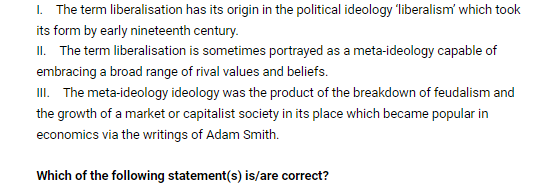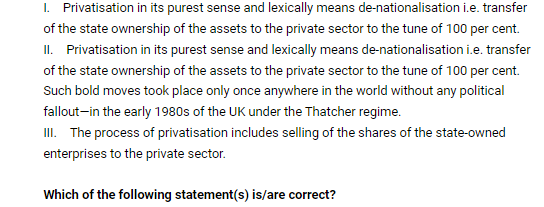1. According to which of the following organisations, the globalisation is “a shift from a world of distinct national economies to a global economy in which production is internationalised and financial capital flows freely and instantly between countries” ?
The developed economies of the world campaigned for the creation of the WTO after an OECD conference in the 1980s, which is better known as the beginning of the Uruguay Round of GATT negotiations that culminated in Marrakesh (1994) with the creation of the WTO. The OECD had also officially defined globalisation in 1995, referring to it as "a change from a world of different national economies to a global economy in which production is internationalised and financial capital flows freely and instantly across countries."
2. Consider the following statements regarding the concept of term ‘ Globalisation’:

Even if the political and cultural aspects of globalisation have always been present, economic terminology have always been employed to describe it. Economic changes have a number of sociopolitical effects once they take place. An growth in economic connectivity across nations is what is commonly referred to as "globalisation." The world's nations embraced globalisation, or "a tighter integration of their economies," even before a number of nation-states were even conceived. The Great Depression and the two Wars, which forced retrenchment and resulted in the construction of various trade barriers beginning in the early 1930s, stopped this period of globalisation, which lasted from 1800 until almost 1930.
3. Consider the following statements regarding the term, liberalisation which show the direction of reform undertaken by Indian Economy:

Liberalisation derives from the political concept 'liberalism', which took shape in the early nineteenth century (it developed basically in the previous three centuries). Sometimes, the phrase is portrayed as a meta-ideology capable of accommodating a vast array of competing values and views. The philosophy was the result of the demise of feudalism and the emergence of a market or capitalist society in its place. It became famous in economics through the writings of Adam Smith (its founder in the United States) and became known as the laissez-faire principle.
4. Consider the following statements regarding the Economic reforms in India:

In response to a fiscal and balance of payment (BoP) crisis, India initiated a sequence of economic reforms on July 23, 1991. The reforms were historic and would alter the entire shape and appearance of the economy in the future. In the middle of the 1980s, the government took its initial efforts toward economic reform. While the deregulation and partial liberalisation of only a few aspects of the existing control regime were relatively limited during the reforms of the 1980s, the reforms that began in the early 1990s in the fields of industries, trade, investment, and later agriculture were much "broader and deeper."
5. Consider the following statements regarding the Macroeconomic Stabilisation Measures adopted by India during the Economic reforms of 1991:

Included under Macroeconomic Stabilisation Measures are all economic policies that aim to increase local or international aggregate demand. For increased domestic demand, emphasis must be placed on raising the purchasing power of the population, which necessitates the provision of lucrative and high-quality employment opportunities.
6. Consider the following statements regarding the term ‘privatisation’, one of the facet of economic reforms in India:

Privatisation in its truest sense and lexically means de-nationalisation, which is the transfer of 100 percent of state-owned assets to the private sector. Such daring moves occurred only once anyplace in the world without political repercussions: in the early 1980s during the Thatcher dictatorship in the United Kingdom. The meaning in which privatisation has been employed is the worldwide process of disinvestment. This procedure entails the sale of state-owned firm shares to the private sector. Disinvestment is the transfer of less than 100 percent of ownership from the government to the private sector.
7. After the “Great Depression of 1929” who among the following suggested ‘strong state intervention’?
J.M. Keynes proposed'strong state intervention,' and such a policy did assist Euro-American nations in mitigating the crisis. The Washington Consensus reversed the prior preference for government intervention in the economy. This consensus, however, was soon to be superseded by a new development strategy.
8. Consider the following information regarding the process of reforms in India during 1990s:

The reform process in India requires the completion of three more processes: liberalisation, privatisation, and globalisation, or LPG for short. These three stages define the characteristics of India's reform process. Liberalisation reveals the direction of reform, privatisation reveals the method of reform, and globalisation reveals the reform's ultimate objective. However, it would be useful to examine the actual meanings of these terms and the precise context in which they are used globally and in India.
9. Consider the following statements regarding the concept of Economic reform:

The process by which a government prescribes a falling role for the state and a rising role for the private sector in an economy is referred to as economic reforms. So let's dissect the reform process based on the author's interactions with students in the classroom. It is more prudent to view economic reform as a shift in an economy's policies or as "alternative development plans."
10. Consider the following statements regarding the Structural Reform Measures adopted by Indian during the Economic reforms of 1991:

Included under Structural Reform Measures are all government-initiated reforms designed to increase the economy's total supply of products and services. It means liberating the economy so that it can pursue its own potential for increased productivity and output. In order to improve the purchasing power of the populace, the economy must generate more money through greater activity levels.
Share your Results:
